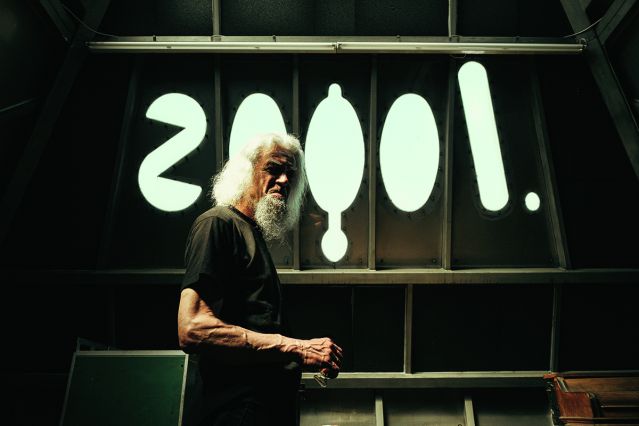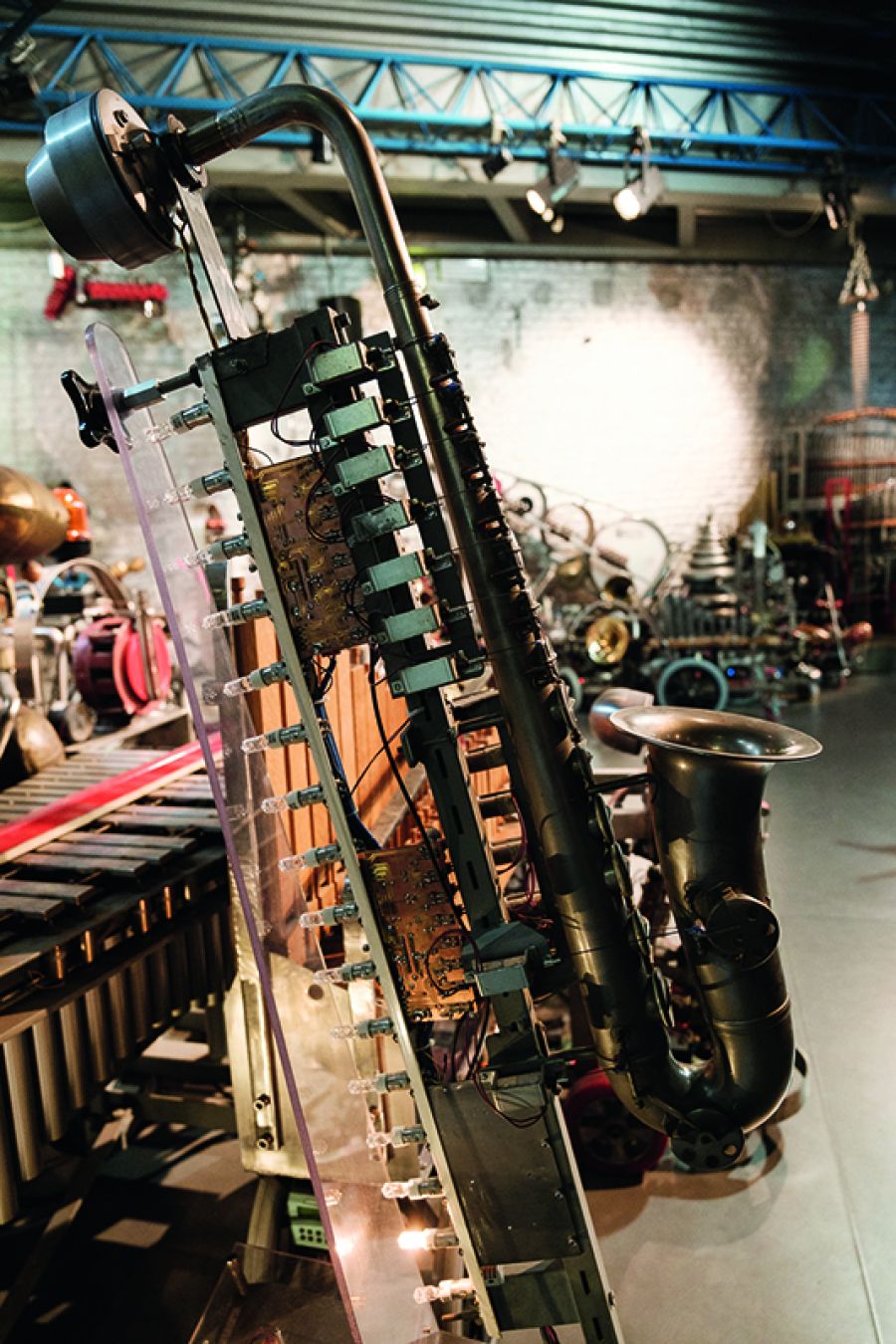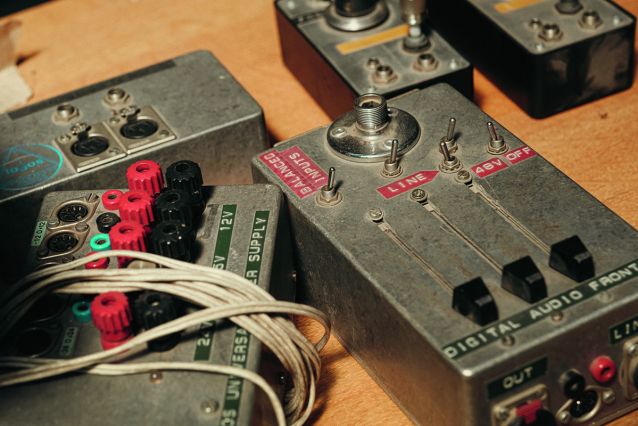Der Gott der singenden Maschine - Deutsche Oper Berlin
The god of the singing machine
Godfried-Willem Raes has been building musical robots in Belgium for half a century, 50 of which will be travelling to the Deutsche Oper Berlin for ZEROTH LAW. A visit to his workshop in Ghent
He immediately gets down to brass tacks when I ring the bell at the Logos Foundation in Ghent. First the music, then the rest. The founder, inventor, engineer, and musician Godfried-Willem Raes soon plays the overture of the Threepenny Opera for me. He sits behind an automated sousaphone at his laptop and activates some of the over 80 musical robots in the room. Organs with wooden and metal pipes, drums, a flugelhorn, a trumpet, and gadgets that Raes designed and built himself. The sounds are acoustic, not electronic, with not a synthesizer in sight. Yet every note is played automatically, without any human input.

The interview quickly takes on a familiar air. “You know, Brecht only wanted one barrel organ for the Threepenny Opera. But Weill ultimately convinced him to go for musicians, because they were cheaper than programming and arranging the music rolls for the organ.” Raes laughs loudly, because this anecdote is the antithesis of what Luddites are always saying. In this case, people took a machine’s job away, not the other way around.
He doesn’t think much of such differentiations. “Nothing is more human than a machine, because only humans can build them. And I know that concert audiences feel compassion when a robot has problems.” A glint of mischief flashes across his eyes, which are bordered at the top by a tall mass of hair and below by a long beard.

Wind instruments are especially demanding. How can you find a technical solution for air pressed between a person’s lips? The inventor blows without a mouthpiece like a trumpet so that his lips are flapping, and says, “That’s enormous pressure resulting in movements that are too fast. It’s difficult to construct.“ We’re standing in front of an “Autosax”, a tenor saxophone that he found at a flea market. It’s one of the first wind instruments that Raes automated.
The lightbulb idea: “You don’t necessarily have to blow. You can suck and the sound is the same. So I invented a mechanism that quickly sends the air back and forth, blowing and then sucking in alternation.” This mechanically creates enough pressure to make the silicone lips on the reed move in nuanced, controllable motions like a saxophone. Or like a mouthpiece on a large sousaphone, where we see that Raes’ robots not only imitate human music, but even do some things better – like play faster, for example, or in more octaves than this type of tuba is even capable of.
Raes has been working on his robot orchestra for over 50 years, building every circuit, soldering every board, writing the software that keeps the orchestra together – conducting, really. The first robot he constructed, in 1968, was even a conductor. It nearly cost him his graduation from the conservatory. Can I have a look? “Oh, he’s in a box without any circuits. But do you want to hear how my robots play Wagner’s VALKYRIE?” I could go without even more German music, and opt for Stravinsky’s “Le sacre du printemps”. It’s a strange spatial experience, when an instrument switches in the middle of a phrase. And the mechanical aspects are suitable for classical modern pieces like those by Weill and Stravinsky, because they contained echoes of the sounds of factories and big cities.

Around 50 of the robots will appear at the Deutsche Oper Berlin as part of a production by Gamut Inc and the RIAS Kammerchor. Marion Wörle and Maciej Śledziecki from the group Gamut Inc frequently go to Ghent to spend a week working with Raes’ Logos Foundation and some of the orchestra’s musical robots.
Giant, taut steel springs ring out loudly and long. The reverberation itself is unique: clear, dry, analytic. This is because of the architecture. The offices and archive of around 36,000 concert recordings by the Logos Stiftung – not yet digitised due to funding issues – are housed in an old, three-storey structure on Kongostraat. Connected to this building is the newer structure from 1990 that Raes built himself from steel, largely welded: the Tetrahedron, a pyramid-like structure. Raes hits his stride: “The Tetrahedron has only 60-degree angles and virtually no traditional right angles. This means there are no resonances that will make it softer, or bassy, or otherwise imprecise. Here, everything sounds neutral or authentic.”
Even an ardent atheist can believe in the truth. Or the eternal. “I got my avoidance of right angles from my employment with Buckminster Filler, who also asked: Why do we choose to build unstable buildings because they have to be cubes? After a certain material mass, a tetrahedron would survive any earthquake.”
We climb up ladders and grated floors to the second and third storeys of his Tetrahedron, where oscillators for old synthesizers are sitting on tables alongside other electronics. A triangular window provides a view of Bomastraat. The afternoon light is cast against the library, which contains many old Goethe volumes in German. “My mother spoke German with me, and I still speak it, but like a child. Goethe keeps it alive: I’ve been working on an opera to Faust II forever. It’ll never be finished.”
Building circuits, writing software, studying Goethe in the original German, putting on welder’s goggles: Godfried-Willem Raes has many skills, and a number of his admirers have called him a Renaissance man because the sciences in the Early Modern Age weren’t as rigidly separated from each other as they are now. Yet his passions and pursuits began in a modern year: 1958, the Expo in Brussels and the Dutch pavilion of the appliance company Philips.
“It used to be that French was the only language allowed in my kindergarten in Brussels, but I only understood German and Dutch. So they kept sending me a few hours away to the Philips Pavilion, where everything was in Dutch.” At the Expo, the six-year-old listened hundreds of times to the “Poème électronique” by composer Edgard Varèse, played over countless loudspeakers installed all throughout the massive, tent-like building by Le Corbusier and Iannis Xenakis.
The Flemish-German boy soon wanted to know where the sound was coming from, partially because some of them sounded like the beeping from the Soviet satellite Sputnik, the first satellite in space. “When I was eleven, the police came by and confiscated my homemade, but illegal radio broadcaster.” Even the conservatory he attended later could not rid him of his love for electronics. Yet, after the first robots, it took a while for Raes to continue building more. “We here at Logos have worked intensively with electronic sound generation, with analogue synthesizers. It’s interesting from a technical perspective, but not suited for the stage. All the audience sees are buttons. A performance without a body, gesticulations, enticement is no performance!”

The solution for the abstraction: Motion sensors, such as those based on radar, made it possible for humans and machines to interact. Raes jumps up and dancily presents the controls. Nearly all the robots have similar systems for interacting in the room. Many have wheels and can be pushed around on the stage, and nothing is constant. “The idea that machines are perfect is a myth. They never will be.“
This breathing imperfection, as it were, is one reason why one of the world’s most innovative techno musicians – Aphex Twin from Britain – orders acoustic instruments from Ghent. Many of Raes’ inventions can be heard on his album “Computer Controlled Acoustic Instruments Part II”. It’s exciting to listen to the robots, and even more fascinating to watch them. These machines are a not-so-new type of seducer. While saying goodbye, Godfried-Willem Raes has his robot orchestra play a tango.
Tobi Müller is a freelance culture journalist and author. He writes and speaks about the performing arts, pop, and digital topics.





